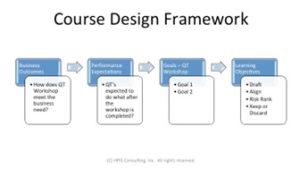
By Vivian Bringslimark
Many QA/HR training managers are responsible for providing a train-the-trainer course for their designated trainers. While some companies send their folks to public workshop offerings, many chose to keep the program in-house. And then an interesting phenomenon occurs: The course content grows with an exciting and overwhelming list of learning objectives.
The supervisors of these subject matter experts (SMEs) struggle with the loss of productivity for the two-to-three-day duration. They quickly develop the “one and done” mindset to cope with their direct reports’ absence.
Given the opportunity to “train” newly identified SMEs as trainers, the instructional designer gets one course to teach them how to be trainers. So, they tend to add “a lot of really cool stuff” to the course in the genuine spirit of sharing, all justifiable in the eyes of the designer. However, there is no hope in breaking this adversarial cycle if the training manager doesn’t know how to cut content.
I used to deliver a two-day (16 hour) workshop for on-the-job training (OJT) trainers. I included all my favorite topics.
Yes, the workshop was long and yes, I loved teaching these concepts. I honestly believed that knowing these “extra” learning theory concepts would make my OJT trainers better. Yes, I was in love with own my content. And then one day, that all changed.
Do They Really Need to Know Maslow’s Hierarchy of Needs?
During a rapid design session I was leading, I got questioned on the need to know Maslow’s Hierarchy of Needs. As I began to deliver my auto-explanation, I stopped mid-sentence. I had an epiphany. My challenger was right.
Before I continued with my response, I feverishly racked my brain thinking about the training standard operating procedures (SOPs) we revised, the forms we created, and reminded myself of the overall goal of the OJT program.
I was searching for that one moment during an OJT session that Maslow was really needed. When would an OJT qualified trainer (QT) use this information back on the job, if ever, I asked myself?
It belongs in the Intermediate qualified trainers workshop, I said out loud. In that moment, that one question exercise was like a laser beam cutting out all nice-to-know content. I eventually removed up to 50% of the content from the workshop.
Oh, But What Content Do We Keep?
Begin with the overall goal of the training program. In my example, it was a defendable and reproducible methodology for OJT. Then seek agreement with key stakeholders on what the learners are expected to do after the course/program is completed.
Capture these as performance expectations. If these responsibilities are not strategic enough or high priority, then the course will not add much business value. Participation remains simply a means to check the compliance box.
Once there is agreement with the stated performance expectations, align the content to match these. (See Figure 1)
Yes, there is still ample room in the course for learning theory, but it is tailored for the need to know only topics. In essence, the learning objectives become more evident. When challenged to add certain topics, the instructional designer now refers to the performance expectations and ranks the consequences of not including the requested new content in the course against the workshop goals for the overall program and the larger business outcomes.
Apply the Same Principle for the Written Assessment
With the growing demand for training effectiveness, the addition of a written test is supposed to illustrate the commitment for compliance expectations around effectiveness and evaluation. To meet this client need, I normally put on my former teacher hat and create a 10-question written assessment.
However, the “test” ends up requiring additional time to execute and hence, the “end of the course” content gets cut to accommodate the allotted classroom duration. My second epiphany occurred during the same rapid design project, albeit a few weeks later:
What is the purpose of the classroom written assessment when back on the job?
The written test was originally designed to ask a lot of questions about content from the workshop; mostly related to the learning objectives. No one could possibly memorize it all. Alas, the request for an open book style was suggested. The rationale was that if they could find the right answers in their materials then they could find the rights answers in their materials while back on the job teaching OJT.
But wait a minute. The OJT qualified trainers are expected to deliver the steps of OJT. The true measure of effectiveness for the workshop is whether they can deliver OJT according to the methodology, not whether they retained 100% of the course content or know where to find it.
So, I removed the knowledge test and created a qualification activity for the OJT qualified trainers to demonstrate their retained knowledge in a simulated demonstration using their new tool, the OJT checklist. Now the OJT qualified trainers workshop is value added and management keeps asking for another round of the workshop to be scheduled.
Vivian Bringslimark is a principal with HPIS Consulting and a member of the LTEN QRDM Training Committee. Email Vivian at vivianbring@comcast.net









